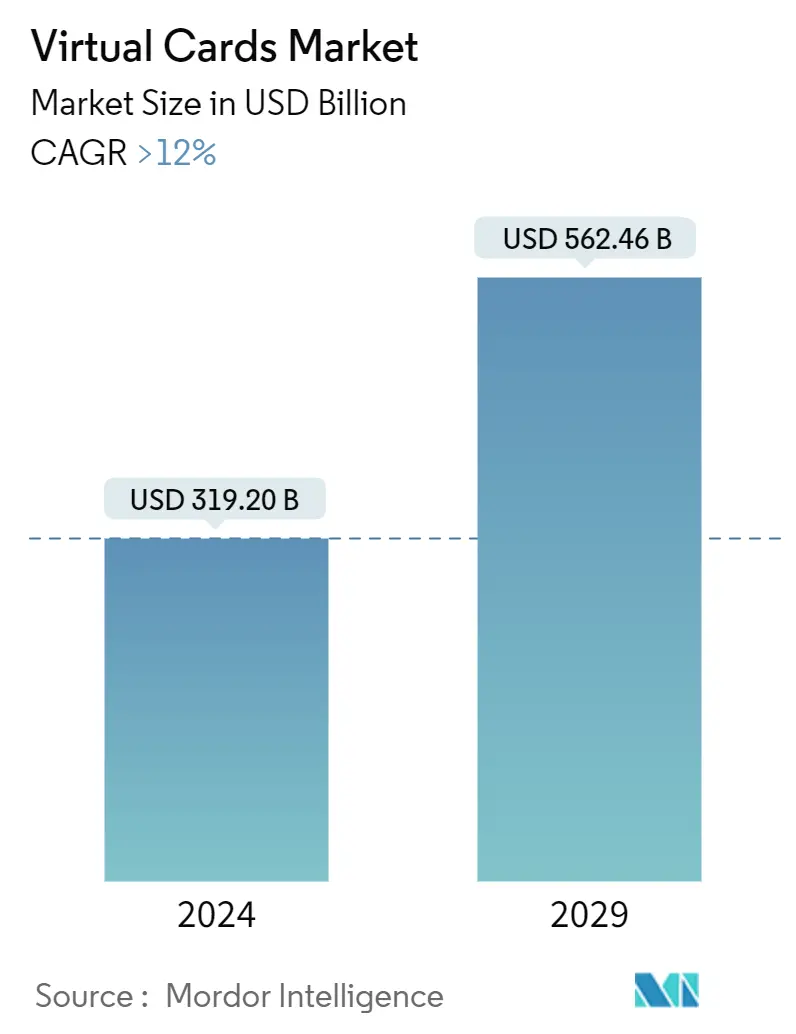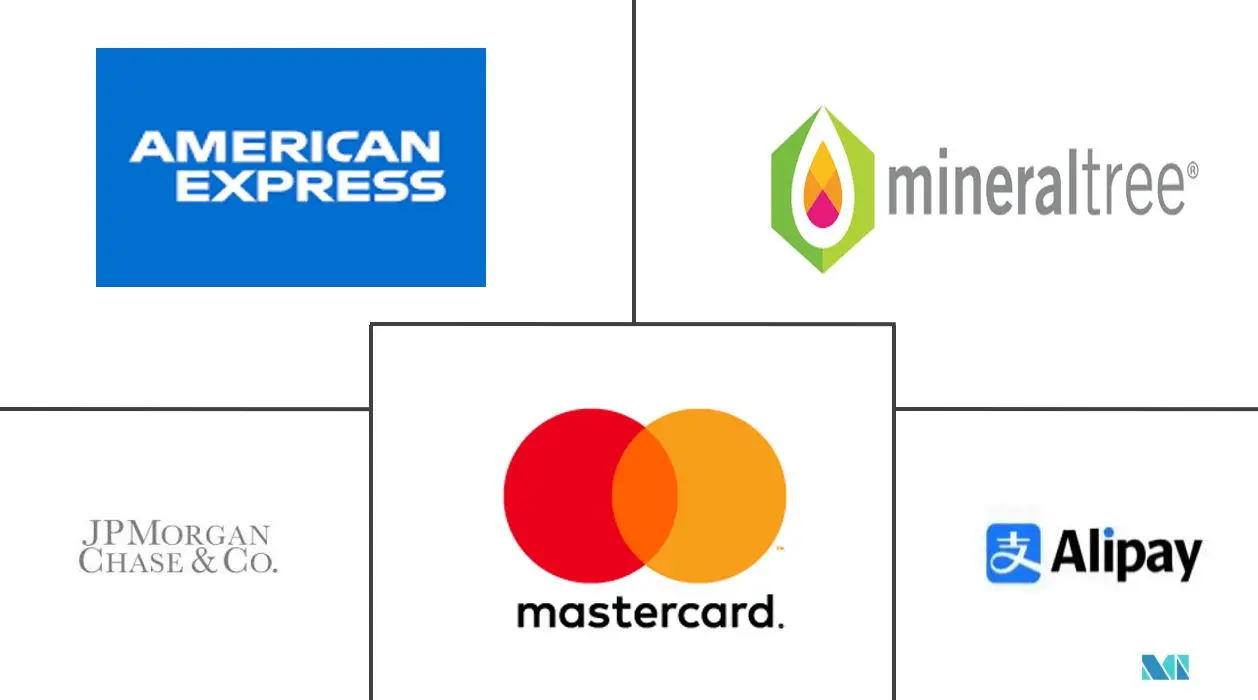Market Size of Virtual Cards Industry

| Study Period | 2020-2029 |
| Market Size (2024) | USD 319.20 Billion |
| Market Size (2029) | USD 562.46 Billion |
| CAGR (2024 - 2029) | 12.00 % |
| Fastest Growing Market | Asia-Pacific |
| Largest Market | North America |
Major Players
*Disclaimer: Major Players sorted in no particular order |
Virtual Cards Market Analysis
The Virtual Cards Market size is estimated at USD 319.20 billion in 2024, and is expected to reach USD 562.46 billion by 2029, growing at a CAGR of greater than 12% during the forecast period (2024-2029).
Over the upcoming years, there will be a notable increase in the market for virtual cards. Due to reasons like the rising use of digital platforms and online payment methods, the industry will rise rapidly. The growing trend of virtual cards is because they save the trouble and cost of handling real cards and processing paper. The epidemic has increased consumer demand for contactless payment options, and the industry is seeing a rapid influx of new contactless spending options. A virtual prepaid card, apart from phone orders and internet transactions, is a digital payment instrument that functions similarly to an actual prepaid card.
Tokenization is used to create credentials randomly, and the cards have integrated financial controls that let you fund the card for single-use or multiple-use purchases. Virtual prepaid cards enhance the payment experience by making online shopping safer, easier, and more capable.
Virtual Cards Industry Segmentation
A credit or debit card is a virtual card number generated via a mobile application or website; a real card does not accompany it. The study contains a thorough background analysis of the virtual card industry, along with an evaluation of the parental market, developing trends by market segments and regional markets, notable shifts in market dynamics, and a market overview. The virtual cards market is segmented by product type, which includes B2B virtual cards, B2C remote payment virtual cards, and B2C POS virtual cards, by end-user, includes consumer use, business use, and by geography, includes North America, South America, Europe, Asia, Pacific, Middle East & Africa. The report offers market size and forecasts for the virtual cards market in terms of revenue (USD) for all the above segments.
| Product Type | |
| B2B Virtual Cards | |
| B2C Remote Payment Virtual Cards | |
| B2C POS Virtual Cards |
| End User | |
| Consumer Use | |
| Business Use |
| By Geography | |||||
| |||||
| |||||
| |||||
| |||||
|
Virtual Cards Market Size Summary
The virtual cards market is poised for significant growth over the forecast period, driven by the increasing adoption of digital platforms and online payment methods. The shift towards virtual cards is largely attributed to their ability to streamline transactions by eliminating the need for physical cards and reducing paper processing costs. The demand for contactless payment options has surged, particularly in the wake of the pandemic, leading to a rapid expansion of new contactless spending solutions. Virtual prepaid cards, which function similarly to traditional prepaid cards, are enhancing the online shopping experience by offering improved security and convenience. The use of tokenization and integrated financial controls further enhances the safety and efficiency of these digital payment instruments, making them an attractive option for consumers and businesses alike.
In the Asia-Pacific region, the evolution of cashless payment methods is being accelerated by innovations such as mobile wallets, peer-to-peer payments, and cryptocurrencies. The region's growing broadband connectivity and mobile commerce, particularly in countries like China, Japan, and India, are facilitating the widespread adoption of contactless payments. This trend is further supported by the rise of e-commerce, digital remittances, and mobile B2B payments, which are expanding the non-cash transaction ecosystem. The increasing use of smartphones and online shopping, driven by urbanization, is expected to further boost the demand for virtual cards. In the B2B sector, virtual cards are gaining traction due to their advanced security features and ability to streamline payment processes, reducing administrative burdens and enhancing integration with existing systems. The market, while concentrated among major players like American Express, JPMorgan Chase, and Mastercard, is also seeing growth from mid-size and smaller businesses through innovation and technology advancements.
Virtual Cards Market Size - Table of Contents
-
1. MARKET DYNAMICS AND INSIGHTS
-
1.1 Market Overview
-
1.2 Market Drivers
-
1.2.1 Digital Transformation is Driving the Market
-
-
1.3 Market Restraints
-
1.3.1 Connectivity and Technical Issues is Restraining the Market
-
-
1.4 Market Opportunities
-
1.4.1 Collaborations between Virtual Card Providers, Fintech Companies, and Financial Institutions can Unlock New Opportunity
-
-
1.5 Industry Attractiveness - Porter's Five Forces Analysis
-
1.5.1 Bargaining Power of Suppliers
-
1.5.2 Bargaining Power of Buyers
-
1.5.3 Threat of New Entrants
-
1.5.4 Threat of Substitutes
-
1.5.5 Intensity of Competitive Rivalry
-
-
1.6 Insights on Impact of Technology and Innovation in the Market
-
1.7 Insights on Performance of Virtual Card Providers Globally
-
1.8 Impact of COVID-19 on the Market
-
-
2. MARKET SEGMENTATION
-
2.1 Product Type
-
2.1.1 B2B Virtual Cards
-
2.1.2 B2C Remote Payment Virtual Cards
-
2.1.3 B2C POS Virtual Cards
-
-
2.2 End User
-
2.2.1 Consumer Use
-
2.2.2 Business Use
-
-
2.3 By Geography
-
2.3.1 North America
-
2.3.1.1 United States
-
2.3.1.2 Canada
-
2.3.1.3 Rest of North America
-
-
2.3.2 South America
-
2.3.2.1 Brazil
-
2.3.2.2 Peru
-
2.3.2.3 Rest of South America
-
-
2.3.3 Europe
-
2.3.3.1 United Kingdom
-
2.3.3.2 Germany
-
2.3.3.3 Rest of Europe
-
-
2.3.4 Asia-Pacific
-
2.3.4.1 India
-
2.3.4.2 Japan
-
2.3.4.3 Rest of Asia-Pacific
-
-
2.3.5 Middle East & Africa
-
2.3.5.1 Saudi Arabia
-
2.3.5.2 United Arab Emirates
-
2.3.5.3 Rest of Middle East & Africa
-
-
-
Virtual Cards Market Size FAQs
How big is the Virtual Cards Market?
The Virtual Cards Market size is expected to reach USD 319.20 billion in 2024 and grow at a CAGR of greater than 12% to reach USD 562.46 billion by 2029.
What is the current Virtual Cards Market size?
In 2024, the Virtual Cards Market size is expected to reach USD 319.20 billion.

